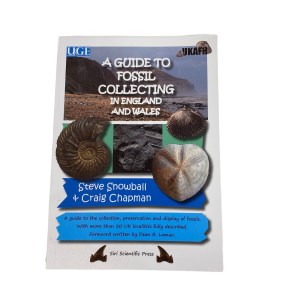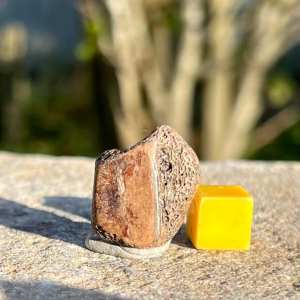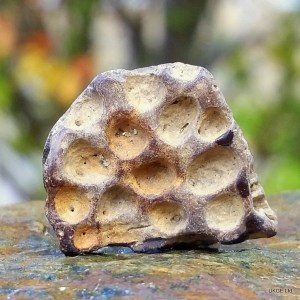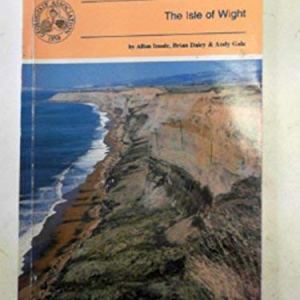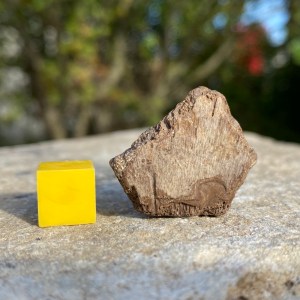The Early Oligocene beds at Yarmouth are highly fossiliferous and mammal, crocodile, turtle, crustaceans and fish remains can all be found. Molluscs, plants and seeds can also be found simply lying on the foreshore.
DIRECTIONS
♦ Unfortunately, due to erosion, the coastal path from the viewpoint is now closed. Instead, you have to park at Victoria Road, which is unsigned and unmade, but is the fifth on left after the view point. There is limited parking for one car only at the entrance. From here, the new redirected coastal path takes you to the foreshore.
♦ You can also follow the footpath, which runs along the cliff to Bouldnor Cliff. This is a longer walk, but much easier.
♦ Ref: 50.70991°N, 1.47246°W
PROFILE INFO
FIND FREQUENCY: ♦♦♦♦♦ – The beds here are highly fossiliferous. The fossils are also very good quality, with superb preservation. This is a fantastic location to visit and the best on the island.
CHILDREN: ♦ – Yarmouth is ideal for families, but access to the shore may be difficult. It can also be a fair walk, so is not recommended for children.
ACCESS: ♦ – All access points from Yarmouth and also from Hamstead Bay and Bouldnor Cliff are difficult. Yarmouth is the hardest, but has the shortest walk.
TYPE: – All fossils here are found on the foreshore. You simply pick them up.
FOSSIL HUNTING
The coastline from Yarmouth, along Bouldnor Cliff, is rich in mammal, crocodile, turtle and fish remains, and seeds, plants, molluscs and crustaceans. Crocodile and turtle plates, and crocodile teeth are the most common fossils. The Hamstead Formation is full of fossil seeds and Stratiotes websterii can be found here, mostly by sieving the formation, since they are very small. There are two species of crocodile, with the most common being Diplocynodon. There are also two species of turtle (Trionyx and Emys). During scouring conditions along Bouldnor Cliff, at the base, the Bembridge Marls are sometimes exposed (but are better exposed at the opposite end at Hamstead Bay). However, the bivalve, Ostrea, can be found compacted within a thin layer. The black and grey-to-green marls contain many different species of mollusc, including the bivalves, Corbicula, Polymesoda and Mytilopsis and the gastropods, Potamides and Melanoides.
From the Hamstead Member, freshwater molluscs such as Viviparus (a gastropod) and Unio (a bivalve) are the most common. However, there are so many that it would be impossible to list them all.
The main place to look at Yarmouth is along the foreshore. Tiny teeth and small remains, which include crocodile, turtle and fish, can be found by getting on your hands and knees, and searching within the shingle on the foreshore, especially at the base of the cliff and along the tideline. Fossils can be found at both access points, either along Bouldnor Cliff or near Yarmouth. Often, if you stay in one area, you can pick up lots of teeth and fragments of bone without moving too far. It is also best to examine the areas where the sea has recently washed out, because, remains can often be found simply lying in the clay areas.
For larger mammalian remains, turtle and crocodile fragments, walk along the foreshore from Yarmouth to Bouldnor Cliff towards Hamstead Bay. You are more likely to find the larger fragments in the middle, between Hamstead Bay and Yarmouth.
GEOLOGY
The foreshore and cliff along this coastline provides the only opportunity (along with the neighbouring Hamstead Bay location) to examine the complete Bouldnor Formation on the Island. Above this, the Cranmore Formation is accessible at the top of the cliff, with the bulk of the cliff between Yarmouth and Bouldnor comprised of the Hamstead Member. The Bembridge Marls at Bouldnor Cliff are often covered up and not visible. It is better to visit Hamstead Bay, if you are aiming to collect from or see the Bembridge Marls.


SAFETY
Common sense when collecting at all locations should be used and knowledge of tide times is essential. The tidal conditions at this location are dangerous and sometimes double tides affect this coast. You must return before the tide turns and must check out tide times before you visit. It is very easy to get cut off.
EQUIPMENT
All the fossils here can be picked up off the foreshore, without the need of any tools. However, it is best to take a few, which may come in useful.
ACCESS RIGHTS
This site is a site of special scientific interest (SSSI). This means you can visit the site, but hammering the bedrock is not permitted. For full information about the reasons for the status of the site and restrictions, download the PDF from Natural England.
It is important to follow our ‘Code of Conduct’ when collecting fossils or visiting any site. Please also read our ‘Terms and Conditions‘
LINKS
♦ Buy Fossils, Crystals, Tools
♦ Location Discussions
♦ Deposits Magazine
♦ Join Fossil Hunts
♦ UK Fossils Network
-
A guide to fossil collecting in England and Wales
£24.20 -
Fossil turtle/crocodile remains – prehistoric reptile fossils
£6.00 -
Geology of the Isle of Wight
£19.40 -
Isle of Wight Fossil Bones, Plates, and Scutes of Turtle/Crocodile – One-of-a-kind Collection
£1.08 -
The Isle of Wight (No. 60) (Geologists’ Association Guides)
£25.00 -
Turtle/Crocodile Fossil Bones, UK, Oligocene, Genuine
£6.24 -
Turtle/Crocodile Fossil Remains – Genuine Specimen – Oligocene UK CERTIFICATED
£5.40

































